Key Takeaways:
- It is important to follow a wedding invitation timeline to ensure guests have enough notice to attend the wedding. This includes sending save the dates or invitations at the appropriate times.
- Determine the timeline for sending out wedding invitations by considering the wedding date and pre-ceremony activities. Typically, formal invitations should be sent eight weeks before the big day.
- When sending formal invitations, include RSVP information and a due date for responses. It is important to ensure everyone on the guest list receives an invitation.
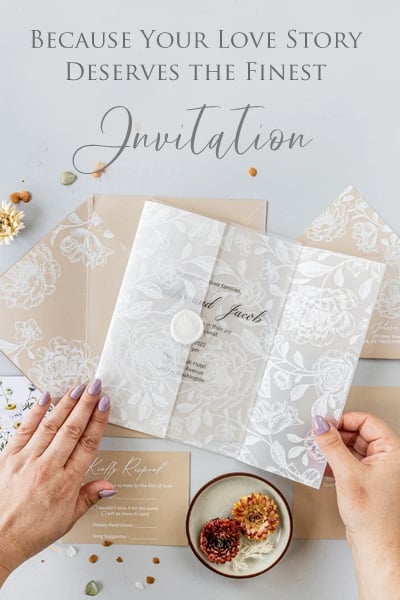
Introduction
To determine the ideal time to send invitations, couples need to consider the wedding date and the length of time guests require to RSVP and make plans accordingly. It's recommended that wedding invitations be mailed six to eight weeks before the wedding date, allowing sufficient time for guests to prepare. For destination weddings or holiday weekends, couples should consider mailing invitations at least three months in advance to provide guests with ample time to plan accordingly.
When sending invitations, timing isn't the only factor to consider. It's also important to select the appropriate design, follow addressing etiquette, and include relevant information such as dress codes and registry details. To ensure that invitations match the wedding's theme and tone, it's a good idea for couples to work with a professional designer.
Overall, the purpose of wedding invitations is twofold: to inform guests of the event's details and to set the tone for the wedding festivities. By thoughtfully considering timing, design, and information provided on the invitations, couples can guarantee that their guests are eager and ready for this special day.
Importance of following a wedding invitation timeline
Planning a wedding requires a lot of attention to detail. Among the many components that need to be put together, sending out wedding invitations is crucial to ensuring that all guests are informed and are able to attend. Hence, following a wedding invitation timeline is very important.
A well-defined wedding invitation timeline can help the couple in numerous ways. Precise timing enables the guests to plan and prepare accordingly. This timeline must be planned in such a way that it provides guests ample time to confirm their availability and make arrangements. Prompt invitations not only maintain a positive etiquette but also make the guests feel important.
Sending out "Save-The-Date" cards before the wedding invites is an excellent way to ensure that the guests block the wedding date and start their arrangements. This will also reduce the last-minute rush and allow ample time for guests to make travel arrangements, especially for out-of-town guests. The wedding invites should be sent out approximately 6-8 weeks before the actual wedding date to ensure that the guests have enough time to prepare their RSVPs.
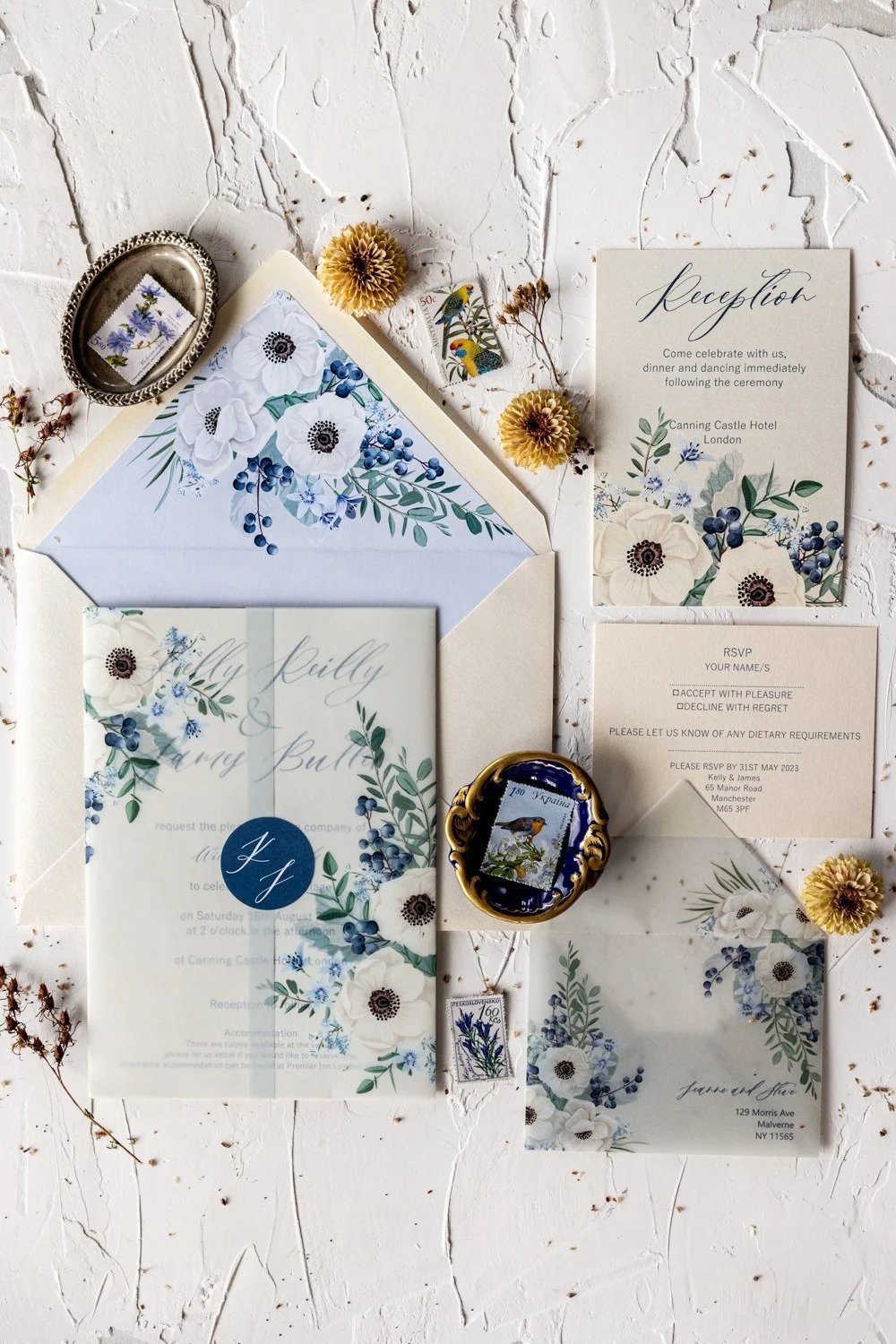
Save the Dates vs. Invitations: When to send which one
Wedding planning involves various critical decisions, among them selecting the appropriate time to send invitations and save-the-dates. Communication with guests plays a vital role in assuring their presence on your big day.
Save-the-dates should be sent 6-8 months before your wedding day, giving guests ample time to prepare, mark their calendars, and make travel arrangements as necessary. Invitations, on the other hand, should be sent 6-8 weeks before the wedding, providing detailed information such as the location and RSVP deadline. It is important to note that for destination weddings, invitations should be sent even earlier than 6-8 weeks.
Although save-the-dates are not obligatory, they are highly recommended for guests who may need to arrange time off work or travel a considerable distance to attend your wedding. For close family members or guests already aware of your wedding plans, however, it is acceptable to skip the save-the-date and send an invitation only.
As a pro tip, consider including RSVP cards with your wedding invitations, complete with pre-stamped envelopes. This thoughtful gesture makes the RSVP process more accessible and organized for your guests and ensures that you receive all the necessary information promptly. In summary, save-the-dates should be sent well ahead of invitations, and adding RSVP cards is a helpful touch for a seamless and stress-free wedding planning experience.
Determining the timeline for sending out wedding invitations
When it comes to weddings, timing is everything - especially when it comes to sending out invitations. In this section, we'll explore the best practices for determining the timeline for sending out wedding invitations. From the ideal timeframe to send save-the-dates to nailing the perfect timeline for mailing the invites themselves, we'll cover all the important details to help you plan your wedding and ensure that your guests are as excited as you are for the big day.
Eight weeks before the big day
Sending out your wedding invitations eight weeks before the big day is a crucial step in the wedding invitation timeline.
Before this, guests should already have received save-the-dates to ensure they have enough notice to attend the wedding.
To make sure that all guests on the list receive their invitations, it's essential to work with a stationery designer or studio to create a complete traditional wedding invitation suite.
Following guidelines for sending formal invitations and requesting RSVPs is also important. Couples must determine the RSVP due date to finalize the guest count and ceremony timing.
In addition, it's essential to plan pre-ceremony activities for guests, such as accommodation options, transportation details, and other events happening before or after the actual ceremony.
In conclusion, sending out your invitations eight weeks before your wedding day plays a vital role in planning a successful event. By working with professionals such as stationery designers and following established timelines, couples can keep their guests informed about pre and post-ceremony happenings.
Nailed the perfect timeline
Creating the perfect timeline for sending out wedding invitations is crucial to ensure that all guests receive the invitations in time to attend. Sending invitations late may result in low attendance and disappointment. To avoid such setbacks, it is essential to plan the timeline correctly and follow a few simple steps.
To nail the perfect timeline for wedding invitations, start by sending save-the-date cards six months before your wedding day. This will allow guests to mark their calendars accordingly and avoid other conflicts. After that, mail formal invitations to your guests at least eight weeks before the big day to give them enough time to respond and make necessary travel arrangements.
It is also important to set an RSVP deadline two weeks before the wedding day. This will give you enough time to finalize guest numbers, seating arrangements, and catering services. Additionally, it is advisable to ensure everyone on the guest list receives an invitation, and pre-wedding activities are planned accordingly.
One unique detail about creating the perfect timeline for wedding invitations is ensuring that guests have access to clear information regarding pre-ceremony details, such as venue locations, parking options or transportation services, dress code requirements (if any), religious practices or restrictions (if applicable), gift registries as well as accommodation facilities if an overnight stay is required. Providing clear information will assist attendees in making adequate preparations ahead of time.
In conclusion, it is crucial to nail down the perfect timeline and stick with it to avoid setbacks like low attendance on the wedding day. I recall a story of a couple who did not finalize their invitation list until four weeks after their set deadline due to family disputes. Consequently, they had delayed sending out their invites, resulting in low attendance on their wedding day. By following the steps outlined above, you can stay organized, reduce stress, and achieve the perfect timeline for your special day.
Guidelines for sending formal invitations and requesting RSVPs
When it comes to formal events like weddings, it's crucial to follow proper etiquette when sending invitations and requesting RSVPs. To ensure that everything goes smoothly, it's important to follow some guidelines.
First and foremost, it's best to send out invitations at least 6-8 weeks before the event. This allows guests adequate time to plan and respond. Additionally, it's a good idea to consider sending out Save the Date cards up to 6 months in advance if the event is taking place during peak travel season.
When requesting RSVPs, make sure to give a clear deadline and offer multiple ways for guests to respond, such as by mail, phone, or online.
It's essential to note that these guidelines can vary depending on the specific event and cultural traditions involved. Nevertheless, following these general guidelines can help ensure that your event runs smoothly, and your guests feel respected and appreciated.
When planning a formal event, it's vital to communicate expectations clearly and professionally. Providing clear instructions and giving guests enough time to respond can help make your event run smoothly and ensure your guests feel comfortable and respected. Don't hesitate to seek advice and guidance from event planners or other professionals if needed.
A complete traditional wedding invitation suite
When it comes to creating a complete traditional wedding invitation suite, there are several vital components that must be included. First and foremost, the invitation itself should feature the names of the bride and groom, along with the all-important details such as date, time, location, and dress code if applicable. In addition to the invitation, a response card and envelope are also crucial. Furthermore, it's important to include any necessary enclosure cards, such as directions to the venue or accommodations.
Sending out the invitations at the right time is also key. It's recommended to mail traditional wedding invitations six to eight weeks before the big day to give guests ample time to plan and make travel arrangements. For guests who are traveling from out of town or attending a destination wedding, it's a good idea to send a save-the-date card six to eight months in advance.
While including all of the traditional components is important, couples can also add unique details to their wedding invitation suites to make them stand out. Customized postage stamps and envelope liners can provide a personal touch, while creative font choices and layouts can make the invitation visually appealing. Additionally, including a wedding website on an enclosure card can give guests even more information about the big day. By incorporating both traditional and unique elements, couples can create a complete and memorable wedding invitation suite that sets the tone for their special day.
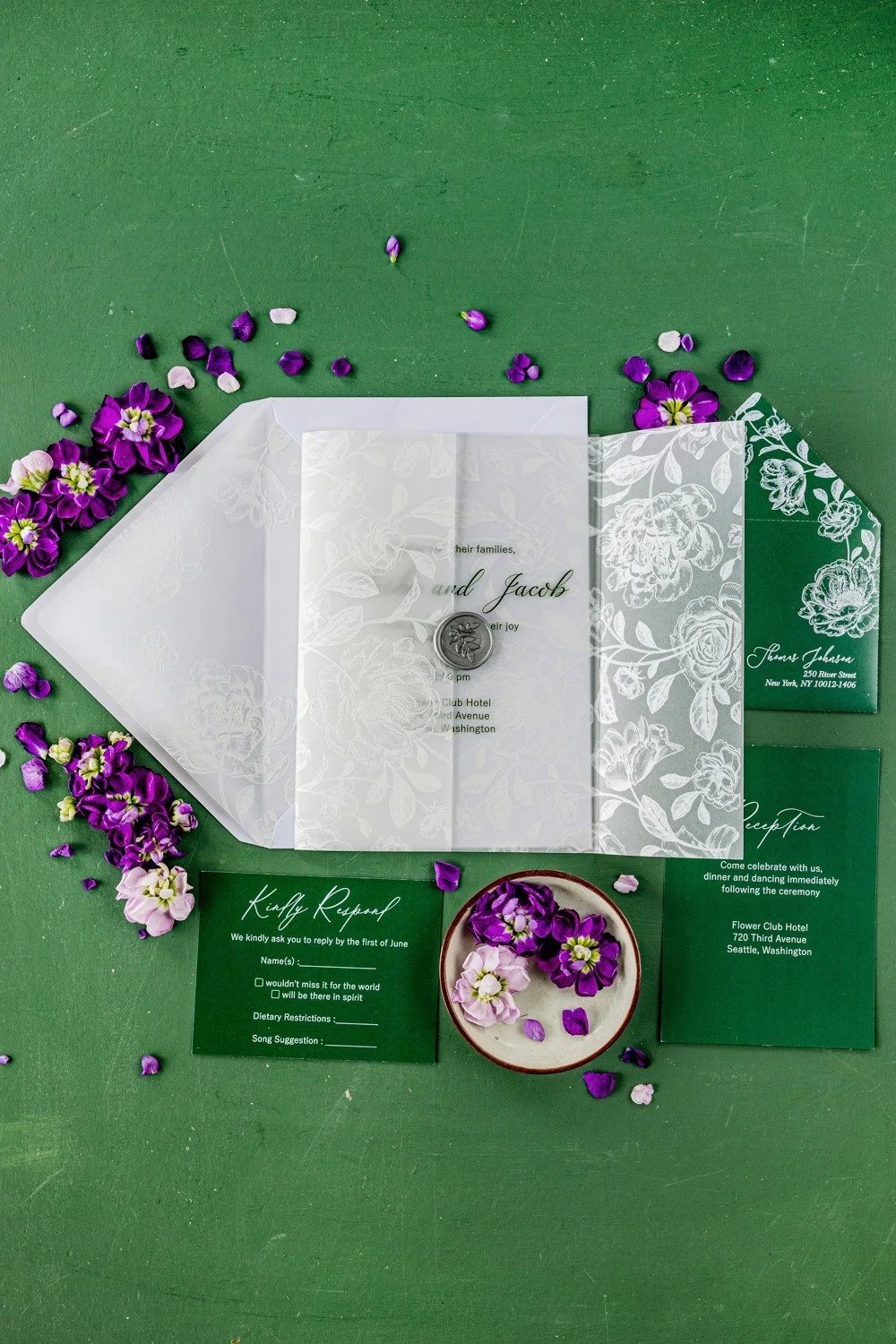
Everyone on the guest list should receive an invitation
It is customary that everyone on the guest list receives an invitation for a wedding. This is important for ensuring that the guests feel welcomed and included in the wedding festivities. Sending out the wedding invitations in a timely manner is crucial to allow guests to make necessary arrangements and to ensure the wedding is well-attended.
The timing of when to send the wedding invitations can vary depending upon the wedding date. In general, it is advisable to send out the invitations at least six to eight weeks before the wedding date. For destination weddings or weddings held during peak season, it is recommended to send out the invitations earlier, at least eight to twelve weeks prior to the wedding.
It is important for the couple to make sure that they have accurate and up-to-date contact information for all of their guests. This information can be gathered through a wedding website, RSVP cards, or through online invitation RSVP services.
Everyone on the guest list should receive an invitation, as not receiving an invitation can make guests feel left out and unimportant. Therefore, it is crucial to make sure the guest list is carefully curated, and everyone on the list is sent an invitation in a timely manner. Each guest is an important part of the wedding celebration, and their presence and participation is greatly appreciated.
RSVP due date and timing the wedding ceremony
Planning a successful wedding involves several crucial elements, including the RSVP due date and timing of the wedding ceremony. It is important for guests to confirm their attendance by the RSVP due date, typically one or two weeks prior to the wedding, to allow the bride and groom to finalize their plans and provide a final headcount to the caterer or venue.
To ensure a smooth wedding ceremony, the timing of the ceremony must be just right. The ceremony should start on time, allowing enough time for the bride, groom, and guests to arrive, settle in, and enjoy the event. It is important to factor in any travel time to ensure that guests arrive at the ceremony on time.
Moreover, couples should consider whether the wedding ceremony will be held in the morning, afternoon, or evening. The time of day can impact the ambiance and dress code for guests, so it is important to take this into account while planning. Additionally, the time of year and the location of the wedding can also influence the timing of the ceremony.
Pre-ceremony activities for guests
Guests who are attending weddings may be eagerly anticipating pre-ceremony activities prior to the big day. However, it's important to remember that timing is everything when it comes to sending out wedding invitations. Ensuring that guests receive their invites with enough time to plan and make travel arrangements is crucial.
In order to make the most of their time before the wedding ceremony, guests can participate in a variety of pre-ceremony activities. These can include attending the rehearsal dinner, where they can meet the family and friends of the happy couple. Alternatively, guests might enjoy joining the bridal shower for an afternoon of tea, games, and gifts. For those who are feeling more adventurous, they could also participate in the bachelor/bachelorette party for a fun night out on the town.
In addition to these more traditional pre-ceremony activities, there are also some unique experiences that guests can enjoy. Wine or cheese tasting events are particularly popular, and attending one of these with the happy couple can enhance the entire wedding experience.
A pro tip for engaged couples is to consider sending save-the-dates six to eight months in advance, with wedding invitations following two to three months before the big day. This timeline ensures that guests have ample time to RSVP and make their travel arrangements, ultimately resulting in a stress-free and enjoyable pre-ceremony experience for everyone involved.
About a wedding stationery designer and studio
If you're a couple looking for unique and perfect invitations and stationery for your big day, consider working with a wedding stationery designer and studio. These professionals have the artistic ability and creativity required to produce exquisite designs that truly represent your vision.
From save-the-dates to invitations, menus, place cards, and thank you cards, a wedding stationery designer can take care of everything. Their experience and professionalism ensure that you receive personalized and high-quality stationery that reflects your style and personality.
One of the benefits of working with a wedding stationery designer is access to a wide range of materials, printing techniques, and design options. You can collaborate with the designer to choose the perfect paper, font, color, and style to match your wedding theme and vision. A wedding stationery studio is equipped with the latest technologies and equipment to ensure that every detail is perfect and that the final product is of the highest quality.
Moreover, wedding stationery designers and studios also provide custom services that allow you to create unique and personalized stationery that reflects your story and journey as a couple. Whether it's incorporating your favorite hobbies and interests or creating customized illustrations or graphics, a wedding stationery designer can make any idea a reality. With endless design options, you have the freedom to create stationery that is as unique as you are.
Essential stationery guides, collections, and information
Stationery is an essential part of any wedding planning process, and it includes more than just invitations. Save the dates, RSVP cards, and thank you notes are also crucial components of a successful wedding communication plan. To ensure that your stationery reaches your guests on time, you must know when to send them.
When considering your wedding stationery, it's essential to think about the invitation collection and the designs that match your wedding theme. You should also check for any necessary add-ons, like maps and dress codes, that you need to include in the invitation. To ensure that your guests receive your stationery on time, you must finalize the delivery date.
Budget, creative ideas, and delivery timings are factors you should consider when making wedding stationery decisions. Identifying these factors will help you design your wording, style, and timeline for mailing your stationery suite to the guests.
In ancient times, invitations were typically announced by word of mouth or a handwritten letter. The process was later modernized, and printed copies were sent out to guests. Over time, stationery designs, formats, and styles have evolved, resulting in a unique collection of items that can add more personalization to your wedding communication plan. Follow the essential stationery guides, collections, and information to ensure that you are successful in your wedding planning process.
Insights on wedding invitations from an etiquette expert
Elaine Swann, a well-known etiquette expert, shares insights on wedding invitations that you won't want to miss. Her expertise in wedding etiquette is highly regarded, making her advice invaluable for anyone planning a wedding. In this section, we'll dive into Elaine Swann's expert tips and etiquette rules for sending out wedding invitations.
Elaine Swann - Etiquette Expert
Elaine Swann, the esteemed etiquette expert, has invaluable tips and guidelines for creating the perfect wedding invitation. She stresses the importance of sending out invitations well in advance, allowing guests ample time to plan and attend the event.
Swann recommends the use of formal language on wedding invitations, ensuring all essential details such as the dress code, RSVP date, and ceremony timing are included. In addition, she advises including pre-ceremony activities for guests to enjoy, enhancing the overall experience.
Swann strongly advises that every guest on the list receive an invitation, and she suggests sending out save-the-dates at least six months prior to the wedding date. Following her expert guidance ensures proper wedding invitation etiquette, reflecting gratitude and appreciation for those attending this once-in-a-lifetime event.
In conclusion, the expertise of Elaine Swann, the renowned etiquette expert, highlights the importance of proper wedding invitation etiquette as a way to show gratitude towards attending guests.
Ensuring guests have enough notice to attend the wedding
When it comes to weddings, ensuring guests have enough notice to attend the wedding is crucial. Sending invitations is essential to notify guests of the wedding, but it's important to send them out with enough time. Traditionally, invitations should be sent 6 to 8 weeks before the wedding, but this varies based on factors such as the location, venue, and time of year of the wedding.
To avoid last-minute cancellations and give guests ample time to prepare for the occasion, it's essential to ensure they have enough notice to attend the wedding. If the wedding is at a popular location or during peak season, invitations should be sent out earlier. Conversely, if the wedding has a smaller guest list or doesn't require travel arrangements, invitations can be sent closer to the wedding date.
In addition to sending invitations, follow-up communication is also important to ensure guests attend the wedding. Save-the-date cards can provide guests with more time to make arrangements for travel and accommodation. It's important to keep in mind that guests who have to travel long distances may require more notice, so timely and detailed communication is crucial.
By staying mindful of these guidelines, you can guarantee that guests have enough notice to attend the wedding without causing any additional stress to the bride or groom.
Conclusion
Wedding invitations are an essential part of the wedding planning process. To ensure that guests have enough time to plan and make necessary arrangements, it is crucial to send them out at least six to eight weeks before the wedding date. Couples can also consider sending out save-the-dates several months before the wedding or setting an RSVP date two to three weeks before the wedding. Timing is key, and an RSVP date that is more than two weeks before the wedding may be too early.
While electronic invitations have become more popular, they may not be as formal as traditional paper invitations. If electronic invitations are the preferred choice, they should be sent out sooner than eight weeks before the wedding date. Couples sending invitations during popular vacation times may want to consider sending the invitations at least four months before the wedding date as guests may already be planning their vacations.
For out-of-town guests, it may be helpful to include a list of accommodations near the wedding venue with rates for convenience. Ultimately, sending wedding invitations serves as a prominent reminder that the couple is soon to be married. When invitations are mailed in a timely manner, guests can make necessary arrangements for their presence on the wedding day, which is a testament of love and respect.
SEO optimized keywords: wedding invitation timeline, save the dates, formal invitations, RSVPs, wedding stationery, wedding etiquette.
Planning a wedding involves several crucial aspects, including the wedding invitation timeline, save the dates, formal invitations, RSVPs, wedding stationery, and wedding etiquette. Properly timed wedding invitations can impact guests' ability to attend, making it crucial to follow a suggested wedding invitation timeline. Couples are advised to send out save-the-date cards six months before the wedding, followed by formal invitations around two to three months before the big day. This gives guests ample time to plan their schedules and make arrangements to attend the wedding.
RSVPs are equally crucial and must be included with the formal invitation. It is important to set a deadline for RSVPs so the couple can have an accurate headcount for their wedding. Choosing the right wedding stationery, such as invitations, place cards, and thank-you notes, can add elegance to the event and leave a lasting impression on guests. Proper wedding etiquette must be followed, such as addressing invitations correctly and including necessary information, to help ensure a smooth-running day.
Couples should also keep in mind any cultural or religious traditions that may impact the timing or wording of wedding invitations. Moreover, creating a wedding website can provide guests with additional information and updates about the wedding. Paying attention to these details can help ensure a memorable and successful wedding day.
Five Facts About When To Send Wedding Invitations:
- ✅ Save the dates should be sent 8+ months before a destination wedding, and 4-6 months for a local wedding. (Source: womangettingmarried.com)
- ✅ The ideal time to send wedding invitations is 6 to 8 weeks before the wedding. (Source: theknot.com)
- ✅ RSVPs should be requested 2 to 3 weeks before the wedding. (Source: theknot.com)
- ✅ Formal invitations should be received by guests no later than 6 weeks in advance. (Source: brides.com)
- ✅ It's important to have something ready for guests to do during the window of time before the ceremony starts. (Source: brides.com)
FAQs about When To Send Wedding Invites ?
When should I send save the dates and wedding invitations?
Save the dates should be sent 8+ months before a destination wedding and 4-6 months for a local wedding. If the wedding is in less than 4 months, skip the Save the Dates and move right to the invites. The ideal time to send wedding invitations is six to eight weeks before the wedding with RSVPs requested two to three weeks before the big day.
What is the perfect timeline for sending wedding invitations?
The perfect timeline for sending out wedding invitations is six to eight weeks before the wedding, with responses requested two weeks before the wedding. Formal invitations should be received by guests no later than six weeks in advance.
What should a traditional wedding invitation suite include?
A traditional wedding invitation suite includes the main invitation, a response card, and any other enclosure cards.
Should I send Save the Dates and invites to everyone on the guest list?
Yes, everyone on the guest list should receive a wedding invitation. This includes Save the Dates for guests who will need to make travel arrangements.
What time should I state on my wedding invitation?
A good rule of thumb is to call the wedding for at least half an hour to 45 minutes before you want the ceremony to begin and state that time on your invitation.
What should I do during the window of time before the ceremony starts?
It's important to have something ready for guests to do during the window of time before the ceremony starts. You can make gorgeous party invitations for the engagement party, bridal shower, or other wedding-related events. You can also find the latest news and little blue studio design to make your wedding invitations look perfect. You can also get insights from etiquette expert Elaine Swann to make sure you've nailed the perfect timeline -- a lot goes into sending invites!
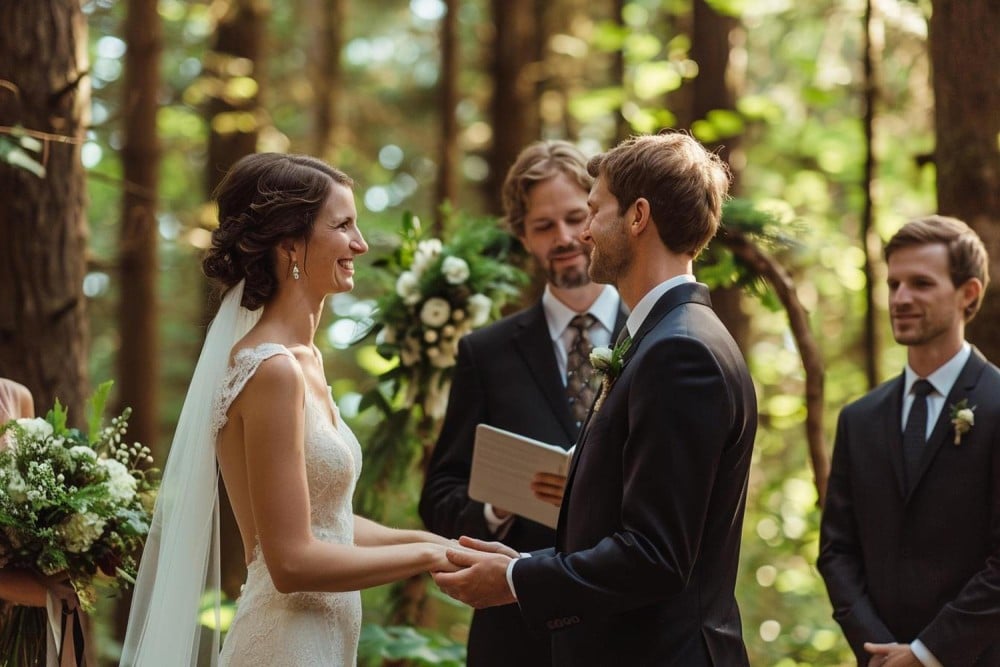 How to become a wedding officiant in tennessee ?Read more
How to become a wedding officiant in tennessee ?Read more How to bustle a tulle wedding dress ?05/21/2024Posted in: Wedding Fashion & StyleRead more
How to bustle a tulle wedding dress ?05/21/2024Posted in: Wedding Fashion & StyleRead more Planning Your Honeymoon Tips for an Unforgettable Trip05/20/2024Posted in: Wedding PreparationsRead more
Planning Your Honeymoon Tips for an Unforgettable Trip05/20/2024Posted in: Wedding PreparationsRead more The Dos and Donts of Wedding Guest Etiquette05/16/2024Posted in: Wedding Traditions & EtiquetteRead more
The Dos and Donts of Wedding Guest Etiquette05/16/2024Posted in: Wedding Traditions & EtiquetteRead more The Importance of PreWedding Counseling What You Should Know05/13/2024Posted in: Wedding PreparationsRead more
The Importance of PreWedding Counseling What You Should Know05/13/2024Posted in: Wedding PreparationsRead more Can I wear beige to a wedding ?11/14/2023Posted in: Wedding Fashion & StyleOne of the most common questions when it comes to wedding guest attire is whether it's appropriate to wear beige to a...Read more
Can I wear beige to a wedding ?11/14/2023Posted in: Wedding Fashion & StyleOne of the most common questions when it comes to wedding guest attire is whether it's appropriate to wear beige to a...Read more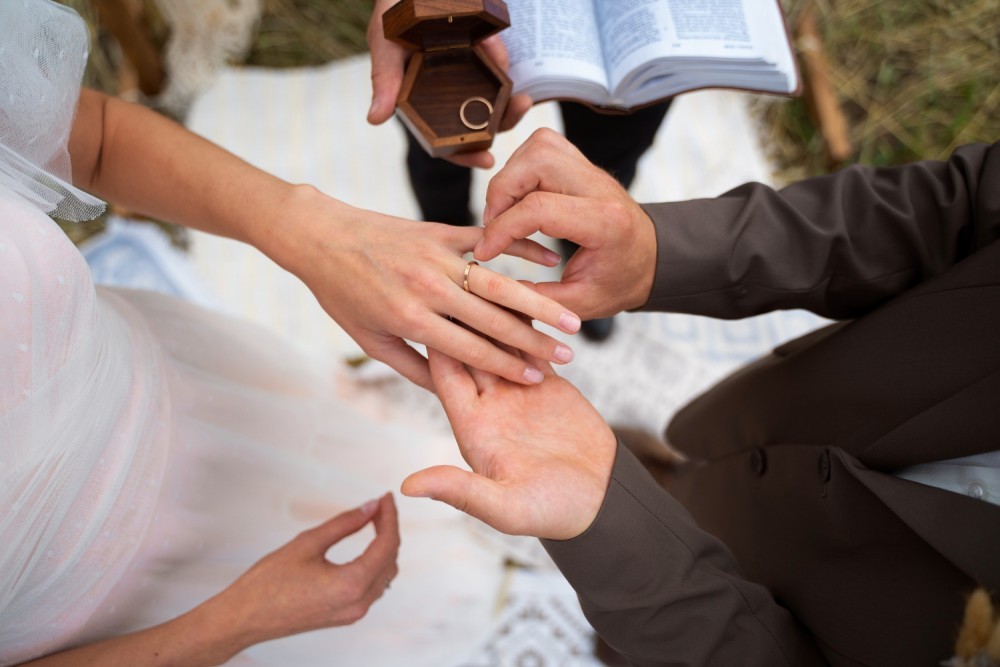 Do Jehovah Witnesses celebrate weddings ?02/29/2024Posted in: Wedding Traditions & EtiquetteJehovah’s Witnesses are known for their distinctive beliefs and practices, but what about weddings? In this...Read more
Do Jehovah Witnesses celebrate weddings ?02/29/2024Posted in: Wedding Traditions & EtiquetteJehovah’s Witnesses are known for their distinctive beliefs and practices, but what about weddings? In this...Read more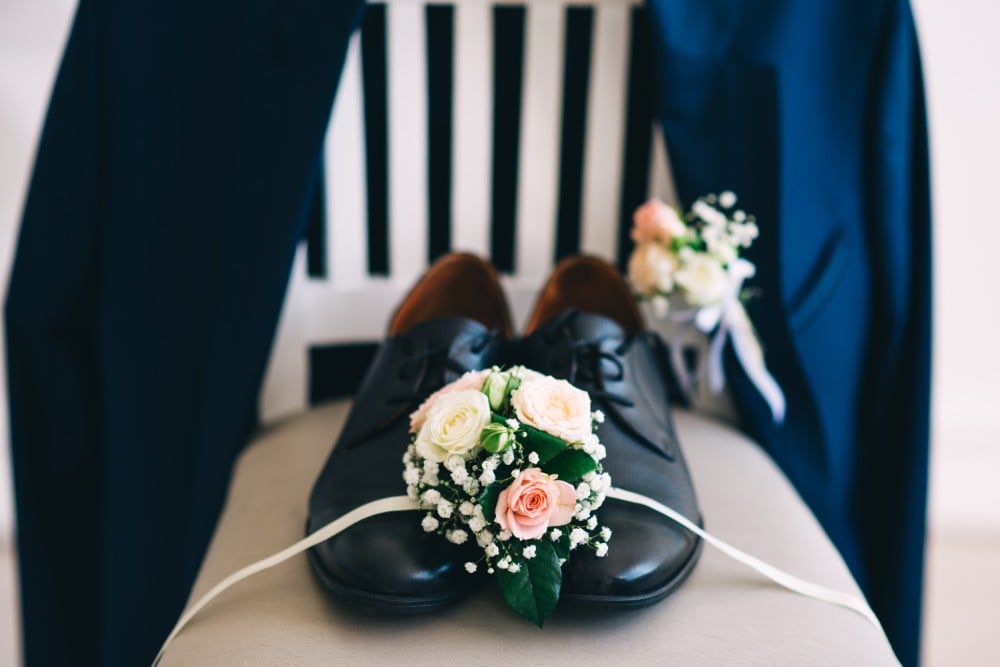 What color shoes with navy dress for Wedding ?08/20/2023Posted in: Wedding Fashion & StyleMatching shoe color with navy dress When teaming shoe color with a navy dress, it's essential to decide on a hue...Read more
What color shoes with navy dress for Wedding ?08/20/2023Posted in: Wedding Fashion & StyleMatching shoe color with navy dress When teaming shoe color with a navy dress, it's essential to decide on a hue...Read more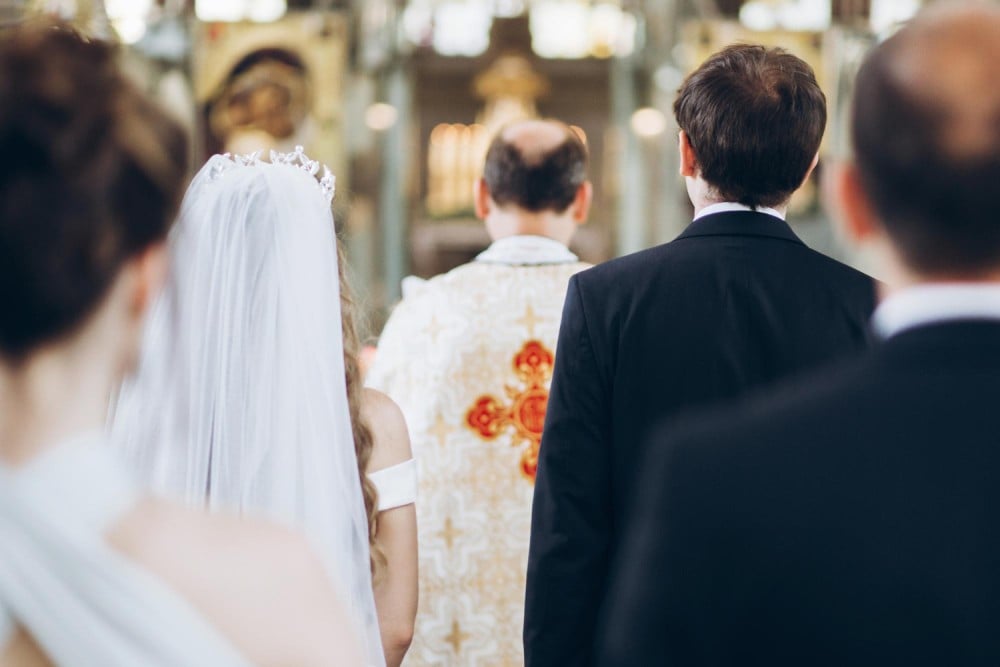 What to wear to a Church Wedding ?09/04/2023Posted in: Wedding Fashion & StyleAre you attending a church wedding and unsure about the dress code? Our latest article provides a deep dive into the...Read more
What to wear to a Church Wedding ?09/04/2023Posted in: Wedding Fashion & StyleAre you attending a church wedding and unsure about the dress code? Our latest article provides a deep dive into the...Read more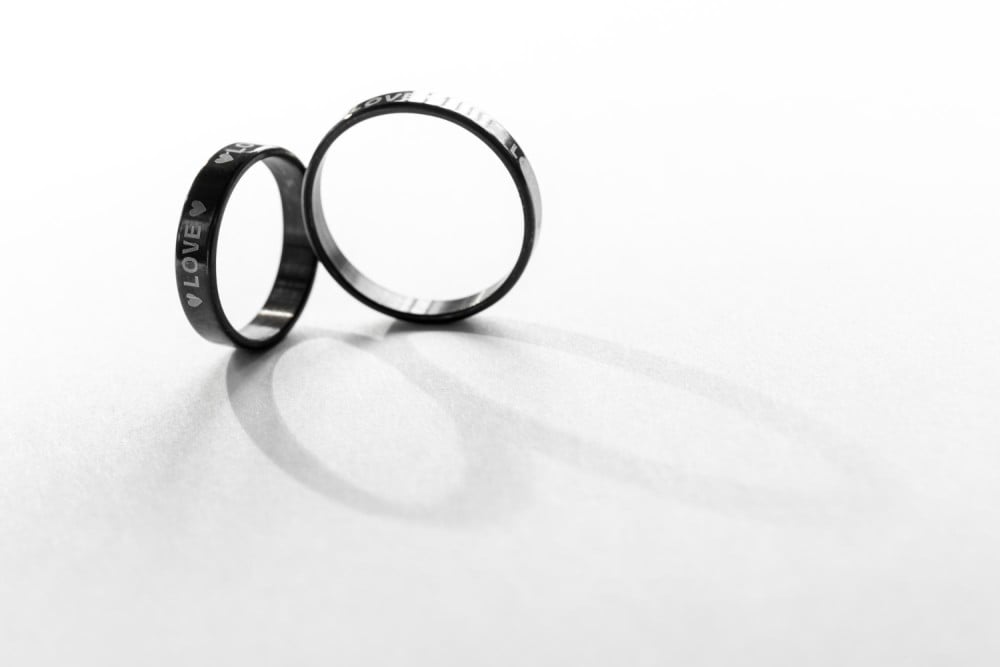 What does a black wedding ring mean ?06/12/2023Posted in: Miscellaneous Wedding AspectsWedding rings are a traditional symbol of love and commitment, but their style and design can vary greatly. In recent...Read more
What does a black wedding ring mean ?06/12/2023Posted in: Miscellaneous Wedding AspectsWedding rings are a traditional symbol of love and commitment, but their style and design can vary greatly. In recent...Read more How to become a wedding officiant in tennessee ?06/27/2024Looking to become a wedding officiant in Tennessee but not sure where to start? This comprehensive guide will walk...Read more
How to become a wedding officiant in tennessee ?06/27/2024Looking to become a wedding officiant in Tennessee but not sure where to start? This comprehensive guide will walk...Read more How to bustle a tulle wedding dress ?05/21/2024Posted in: Wedding Fashion & StyleAre you a bride-to-be with a tulle wedding dress and wondering how to bustle it for the big day? Look no further!...Read more
How to bustle a tulle wedding dress ?05/21/2024Posted in: Wedding Fashion & StyleAre you a bride-to-be with a tulle wedding dress and wondering how to bustle it for the big day? Look no further!...Read more Planning Your Honeymoon Tips for an Unforgettable Trip05/20/2024Posted in: Wedding PreparationsPlanning your honeymoon is an exciting and important step in beginning your life together as a married couple. From...Read more
Planning Your Honeymoon Tips for an Unforgettable Trip05/20/2024Posted in: Wedding PreparationsPlanning your honeymoon is an exciting and important step in beginning your life together as a married couple. From...Read more The Dos and Donts of Wedding Guest Etiquette05/16/2024Posted in: Wedding Traditions & EtiquettePlanning to attend a wedding soon? Make sure you brush up on your wedding guest etiquette to ensure you have a great...Read more
The Dos and Donts of Wedding Guest Etiquette05/16/2024Posted in: Wedding Traditions & EtiquettePlanning to attend a wedding soon? Make sure you brush up on your wedding guest etiquette to ensure you have a great...Read more The Importance of PreWedding Counseling What You Should Know05/13/2024Posted in: Wedding PreparationsAre you and your partner considering pre-marriage counseling but not sure what to expect? This article is here to...Read more
The Importance of PreWedding Counseling What You Should Know05/13/2024Posted in: Wedding PreparationsAre you and your partner considering pre-marriage counseling but not sure what to expect? This article is here to...Read more








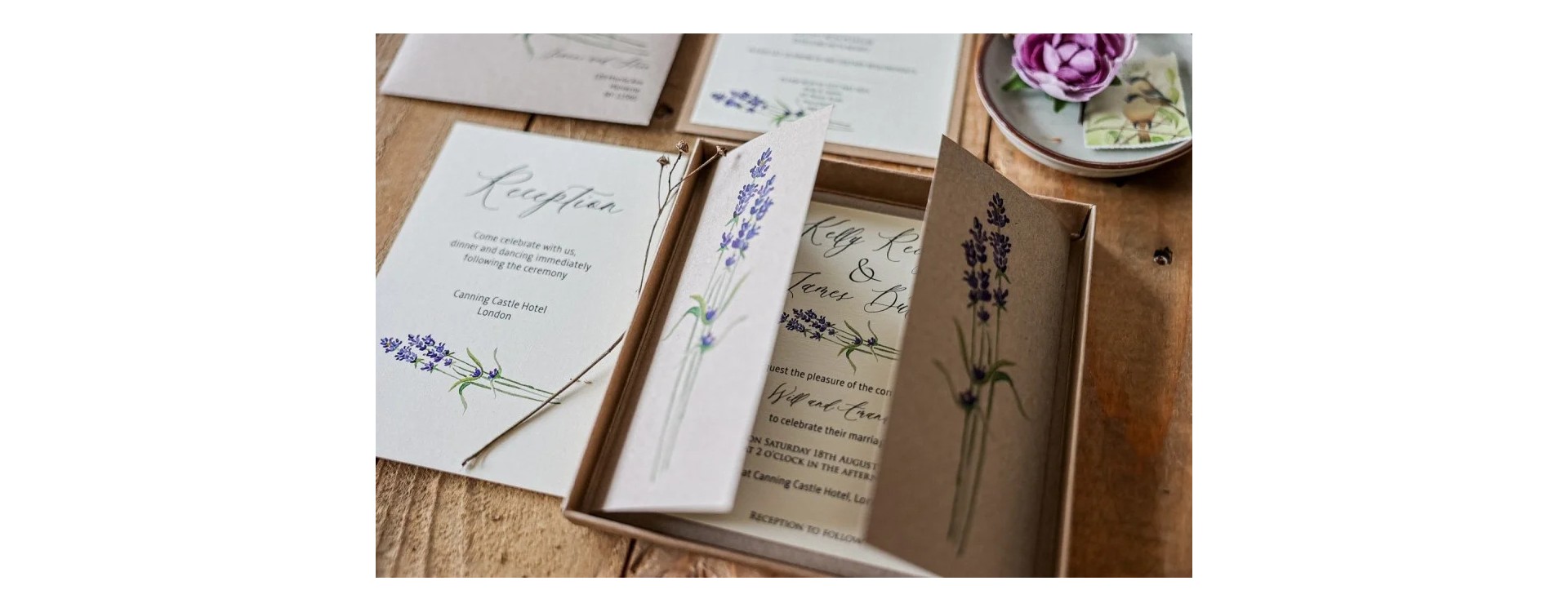



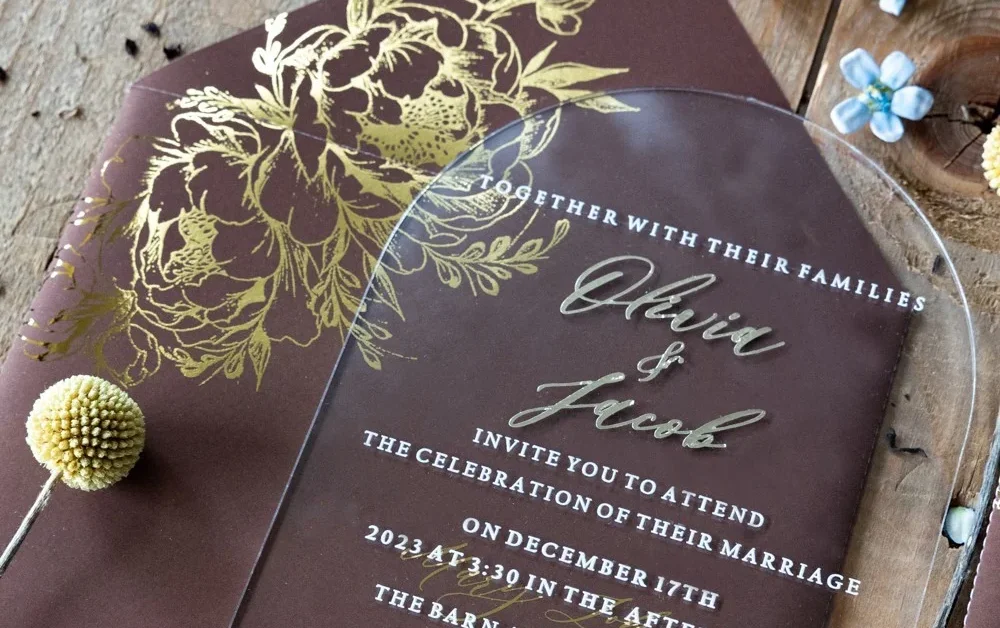

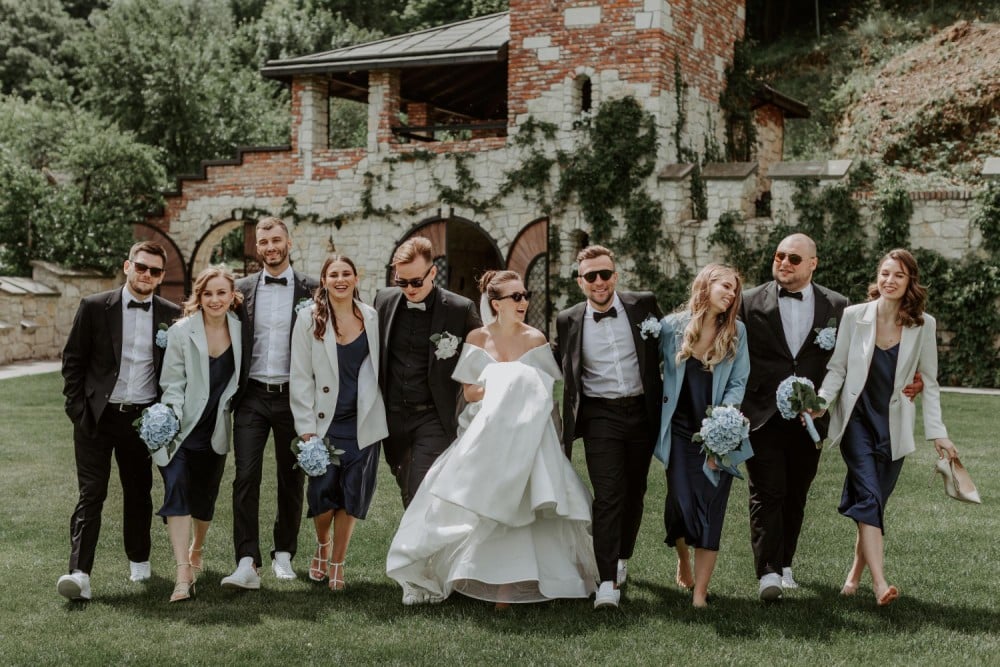
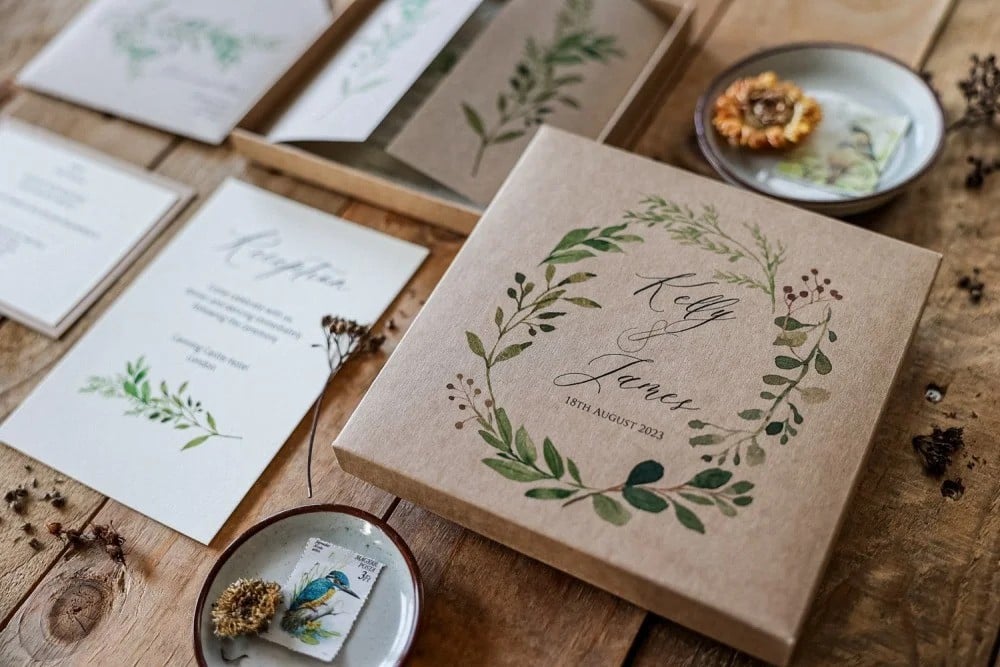

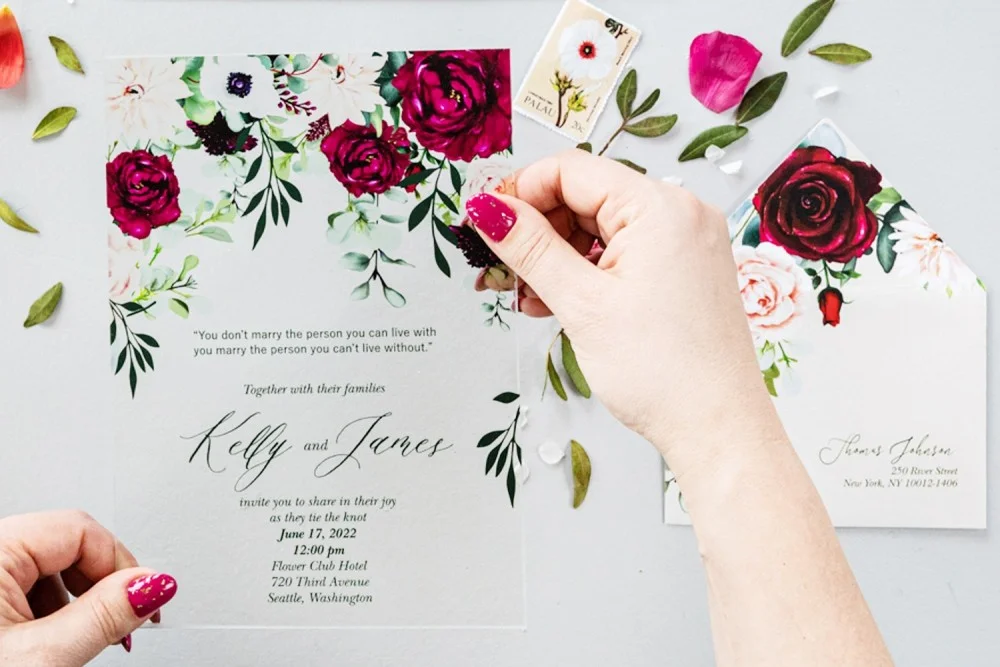
Top authors